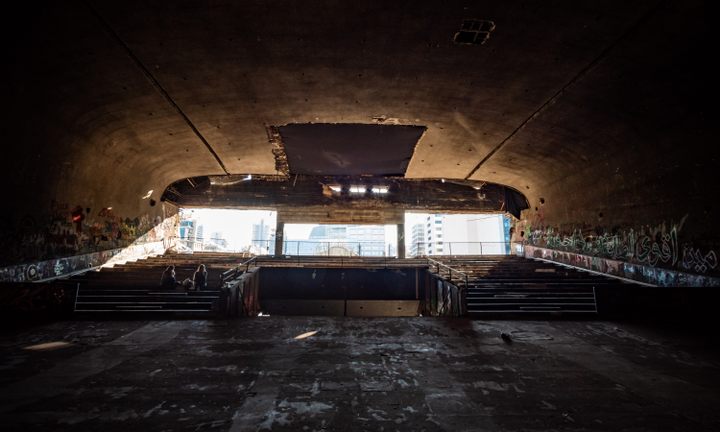
How an Abandoned Modernist Cinema Became a Revolutionary Symbol in Lebanon
The Beirut Egg is riddled with bullet holes and covered in graffiti. Protesters recently reclaimed it.
A few months ago, a trickle of protesters converged on downtown Beirut, spurred by a proposed tax on the text-messaging platform WhatsApp. Within a few days, the crowd had swelled, and so had its aims: Demonstrators spoke out against sectarian rule, unemployment, and development that had transformed the area where they were standing into a playground for the rich. Their efforts helped oust the prime minister, but the protests have continued, and they have faced violent crackdowns by security forces.
In recent months, once or twice a week, a guide named Sari Haddad has walked visitors through this evolving story. Leading one group through Martyrs’ Square, which is now partially occupied by tents and art installations, his eyes widen as he recounts the initial protest growing into a movement of millions of people, eventually taking over this once-sterile strip of downtown.
Behind him stands one of the protesters’ greatest prizes: the Egg. The abandoned cinema—a brutalist concrete dome, missing swaths of wall and riddled with bullet holes—looks like it’s from a different universe, next to the enormous Mohammad Al-Amin Mosque and sleek high-rise apartments. On the first day of the protests, the wooden boards surrounding the Egg were torn down, restoring access to one of the city’s strangest sites.

During Haddad’s story, a protester approaches the group. He’s one of the many war veterans who have taken to the streets and are now selling trinkets to pedestrians. He offers to sell a single lira coin—a bitter souvenir in a country going through a financial crisis. You would need more than 1,500 of them to make a single U.S. dollar at the official exchange rate, and over 2,000 on the black market. He motions to the Egg and says that this coin was once enough to see a movie there.
For many Beiruti, the Egg—officially part of an unfinished project called Beirut City Center complex—symbolizes both the bygone days of Beirut and the years of war that followed. The structure survived the Lebanese Civil War in the 1970s and ’80s, despite being located on the front line between East and West Beirut. Perhaps more impressively, it also survived the reconstruction and post-war boom that totally transformed the downtown area. It remained closed to the public for years as developers argued its fate—until recently.

For the younger generation in Lebanon, the Egg was a mystery. “No one knew anything about it,” says Haddad, who is 26. It was just a curious remnant of a forgotten Beirut, he says. He and his friends weren’t interested in the downtown area, with its luxury stores and apartments built after the war. “For us, we don’t know anything about what downtown was,” he says. “We have no connection to it.”
But older residents have never forgotten the building’s significance. Philippine Eid, who is 84, says that some of her best memories come from this stretch of downtown Beirut. “At night it was a place to breathe,” she says.
When the dome of the Egg was completed in the 1960s, she was a young woman, still finishing school. A number of theaters and cinemas were already in this section of downtown where Eid lived, near the old souk and a short walk to the rocky coast of the Mediterranean. She would often visit the strangely shaped cinema with her girlfriends, to watch films from Hollywood and Egypt. She liked walking on the soft red carpet and watching the lighting reflect off the walls and ceiling.
At that time, the patrons included those from every sect and neighborhood of the city. “No one was excluded,” Eid says. “Everyone was welcome.”

Once, Eid sat in the front row of the Egg to watch a live bodybuilding show, and was amazed by the oiled men posing on stage. As it turned out, one of them was also impressed with her, and later found her at the exit—muscles respectfully covered—to ask her out. She refused, but still thinks about it decades later with a smile.
The last time she visited was at age 20, already married and with a newborn son. She had to leave early after he began crying. Still, she looks back fondly on the building. “It was very elegant,” she said.
The ’60s were a golden age not only for cinema in the country but also for architecture, says Rony Hobeika of the Lebanese American University’s School of Architecture and Design. A generation of modernist architects, many educated in the West, picked up commissions from the government and private developers.
Joseph Philippe Karam, an architect who experimented with concrete and modern designs, built the Egg along with many other buildings in the city. His cohort of Lebanese architects were optimistic about what was possible. “That was the spirit of the time,” Hobeika says. “They thought they could build utopia with concrete.”

Unfortunately, that period of optimism came to a dramatic end with the start of the civil war, in 1975. The city’s concrete buildings became makeshift bunkers, and the Egg sat on the Green Line—a no-man’s land between Christian and Muslim communities in Beirut, so named because it sprouted lush foliage in the absence of foot traffic. After the war, a reconstruction effort led by the development firm Solidere destroyed more buildings than the fighting had.
As old Beirut was bulldozed, the Egg—constantly threatened by developers—somehow remained standing. In 2009, after the building was nearly demolished, local activists began a “Save the Egg” campaign. Its entrance was closed to the public (although a rave or two was permitted).
It was during this time, decades after the war, that a young generation of illustrators, painters, photographers, and musicians turned the building into a pop icon, says Melissa Khoury, a researcher at the Lebanese American University. “When a building represents what people experienced in the city, it becomes more than just a hunk of cement and metal wires,” Khoury says. “It becomes somehow part of the people.”
That’s also why it can be so painful when it’s threatened with destruction, she says, or inspire such joy when saved.
A couple of weeks after his revolution-themed walking tour, Haddad ducks under a rusted railing to enter the Egg. The dome of the building is raised above a space designed for a shopping center. Large and colorful murals—a rat representing a devious politician, the face of Joaquin Phoenix in Joker—splash color across the concrete walls. Stairs lead up and into the shell.
Haddad, who entered the Egg on the second day of the protests, says he was careful climbing these stairs at first, unsure whether they would hold his weight.

The inside of the Egg looks like a post-apocalyptic planetarium. The curved wall is tagged and painted wherever reachable. Bare steps, built for theater seating, provide a natural spot where visitors sit and smoke cigarettes and take photos, and where protesters hold meetings. “The revolution gave us back our public property,” Haddad says. “So we raved inside the Egg. We watched movies inside the Egg.”
The back wall of the structure is missing, allowing afternoon sunlight to flood the space and revealing a view of the Ring Bridge—often the site of road blocks by protesters. The skyline of Beirut pits new buildings against old, war-scarred tenements. “It was a view that was new for us,” says Haddad, looking in that direction.
For those brave enough, there’s one more level of the Egg that’s reachable. Outside of the shell, across a wooden plank that bridges a steep drop, is a narrow section of metal stairs leading to the roof. After a shaky climb, one can look down on Martyrs’ Square and the cluster of tents and vendors that occupy former parking lots. Someone who reached this point earlier has dripped a rainbow of paint down the side of the building.

As a group of teenagers film a parkour video nearby, Haddad dreams aloud of what else might be done here. The space could house daily screenings or serve as a gallery for local artists, or host 1,000 ravers like Berlin’s best industrial clubs.
But after more than 100 days, the revolution has taken a dark turn. Protesters regularly clash with riot police, throwing rocks and fireworks, facing tear gas and rubber bullets in return. A new prime minister has finally formed a government, but doesn’t have the support of those camped in front of the Egg.
Some barriers were torn down in October, but now others are appearing. Concrete walls block the alleys leading to the Parliament of Lebanon, in an effort to stop protesters from rushing the building.
Yet the Egg remains open. Many nights, visitors can stand inside, shielded from tear gas and riot police, listening to the chants of protesters who want a new Lebanon.
You can join the conversation about this and other stories in the Atlas Obscura Community Forums.
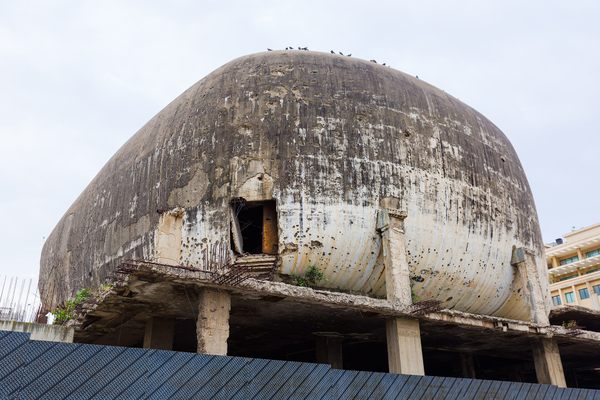


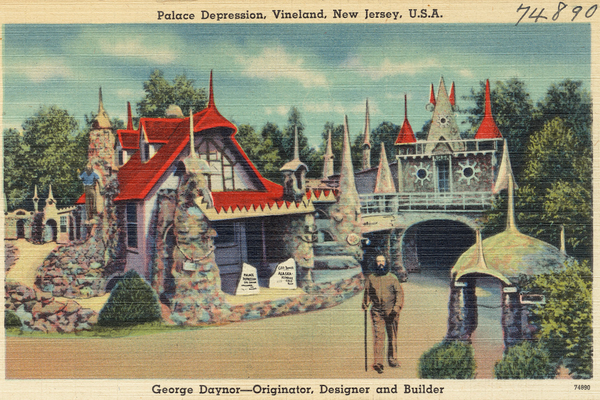
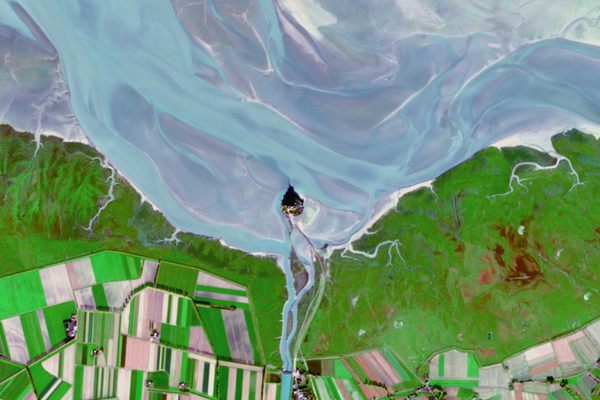

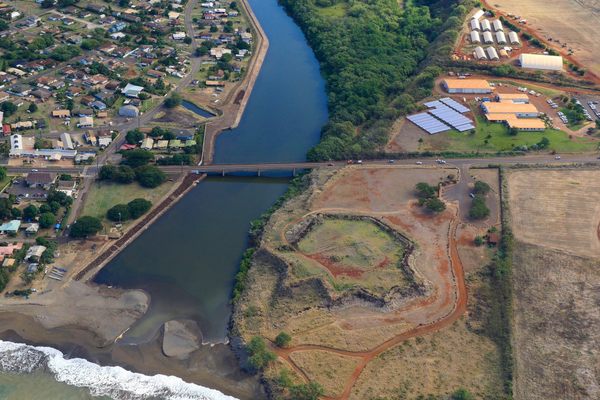



























Follow us on Twitter to get the latest on the world's hidden wonders.
Like us on Facebook to get the latest on the world's hidden wonders.
Follow us on Twitter Like us on Facebook